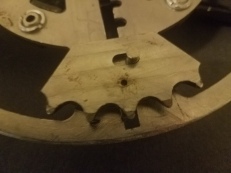So, I conducted some more extensive road tests in April and May. The results were mixed. VECTr was definitely able to bear real life loads as I pedaled myself on neighborhood streets and up modest inclines. But I found that over more extended periods of riding, the chain would indeed slip, even when there was not much of a load on the chain. I did some more careful observations with the bike on the repair stand, and found that the teeth were not quite aligning with the links of the chain, and that this was the cause of the slippage. In January, I had redesigned the gear segments with tapped holes for receiving 1/4 inch bolts to secure them to the base plate. In the process, the teeth had changed a couple of millimeters from the prior design, and so were not syncing with the chain as the prior design had.

Gear segments affixed with 1/4 inch bolts
Road tests also revealed a problem in using bolts to affix the gear segments to the base plate. The force applied to the pedals to drive the chain passed through, as it were, the base plate to the gear segments, but as it did so, the threads of the bolts affixing the gear segments to the base plate dug into the grooves or guide tracks in which they would slide when being moved to a new radial position. Consequently, this force being concentrated on the bolts caused deformations in the edge of the guide tracks, and thus hindered the free movement of the gear segments when it came time for them to slide to their new radial position. This was a more serious problem that would need to be addressed

Deformation of guide track
Although using bolts to both affix the gear segments to the base plate and to slide in the guide tracks was, in a sense, simpler and less expensive than other possible designs, the deformation of the surface of the guide tracks meant that I would need to find another way for the gear segments to slide without such problems. I spent a couple of weeks redesigning the gear segments with five instead of just four teeth, but in the proper dimensions to sync with the chain, and incorporating guiding flanges to distribute the load of the forces transferring from the base plate through the gear segments to the chain so as to prevent deforming the edge of the guide tracks.

 It took some time to get the new gear segments machined, but when mounted and tested for chain sync, they worked perfectly. I conducted some in-lab (utility room) and brief road tests, and they were able to drive the chain well. Gear changes, though, were inconsistent due to issues with the control assembly.
It took some time to get the new gear segments machined, but when mounted and tested for chain sync, they worked perfectly. I conducted some in-lab (utility room) and brief road tests, and they were able to drive the chain well. Gear changes, though, were inconsistent due to issues with the control assembly.

In my last post I noted that the operation of VECTr tended to cause the controller assembly to go out of alignment and distort the bracket which mounted it on the bicycle frame. I therefore designed a new more sturdy and robust controller assembly and had it machined. Fitting the new assembly to the frame turned out to be more difficult than anticipated, but with some modifications, I was able to mount it and it was ready for another round of testing.
Initial in-lab tests show the new gear segments and controller assembly allow VECTr to run much more smoothly, confirming the potential within the ideas at the core of the Variably Expanding Chain Transmission design. See the video below for a demonstration of VECTr on the bicycle in the lab.
Next time: new road tests!